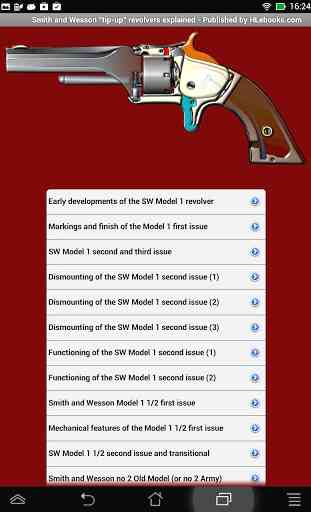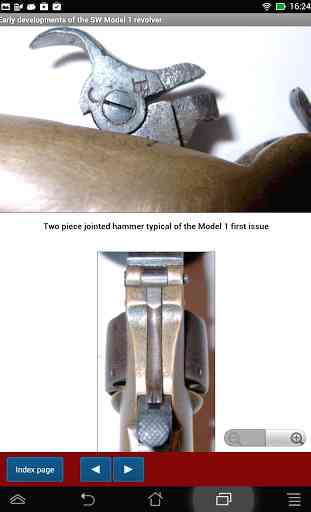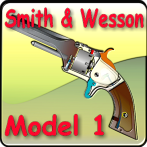Smith & Wesson revolver Mod. 1
Early developments of the S&W Model 1 revolver
- F. H. Harrington patent #20607 (jointed hammer)
- Leaf spring barrel catch and separate ratchet
- Remedies to the cartridge bulging issue
- General characteristics of the Model 1 first issue
- Typical features of the first type
- Typical features of the second type
- Typical features of the third type
- Typical features of the fourth type
- Typical features of the fifth type
- Typical features of the sixth typeMarkings and finish of the Model 1 first issue revolver
- Firm and patent markings
- Serial numbers and assembly markings
- Metal finish and presentation cases
- Luxury engraved version with mother of pearl grip plates
- Gutta percha presentation case by Littlefield Parsons & Co.
- Second model of gutta percha case known as the "Stand of Flags"S&W Model 1 second and third issue
- Typical S&W Model 1 second issue
- Production of the S&W Model 1 second issue
- General characteristics of the Model 1 second issue
- Markings found on the S&W Model 1 second issue
- "2D QUAL'TY" marking
- S&W Model 1 third issue
- Early and later top strap profile
- General characteristics of the Model 1 second issue
- Markings found on the S&W Model 1 third issue
- Nickel plating of firearms
- Model 1 third issue "Target Model"Dismounting of the S&W Model 1 second issue (I)
- Removal of the cylinder
- Dismounting the cylinder inner axial stud
- Detachment of the barrel from the frame
- Disassembly of the barrel latch
- Removal of the grip platesDismounting of the S&W Model 1 second issue (II)
- Removal of the sideplate
- Dismounting of the main spring
- Dismounting of the hammer assembly from the frame
- Disassembling of the hammer components
- Hammer pivot in the frameDismounting of the S&W Model 1 second issue (III)
- Dismounting of the trigger
- Dismounting of the cylinder stop
- Index of the partsFunctioning of the S&W Model 1 second issue (I)
- Functioning of the trigger mechanism
- Weakness of the barrel attachment
- Barrel latch explainedFunctioning of the S&W Model 1 second issue (II)
- Adjustment of the cylinder inner stud
- Functioning of the cylinder stopS&W Model 1 1/2 first issue
- General characteristics of the Model 1 1/2 first issue
- Variations of this model that must draw attention
- Firm and patent markings found on the S&W Model 1 1/2 first issue
- Serial number markings found on the S&W Model 1 1/2 first issue
- Location of the assembly markings
- Assembly marking on the rear face of the trigger
- Notable areas of weaknessMechanical features of the Model 1 1/2 first issue
- Cylinder adjustment
- Modified tool tip to accommodate the cylinder stud
- Precise positioning of the forward lug of the cylinder
- Functioning of the cylinder stop in the bottom frame strapS&W Model 1 1/2 second issue and transitional
- General characteristics of the Model 1 1/2 first issue
- Firm and patent markings on the S&W Model 1 1/2 second issue
- Serial number markings
- Location of the assembly markings
- Cylinder stop features
- S&W Model 1 1/2 transitional
- For those who might thought of "building" a transitional modelSmith & Wesson no 2 Old Model (or no 2 Army)
- General characteristics of the no 2 Old Model
- Old type of hammer knurling
- Later trigger checkering
- Grip escutcheon and screw variations
- Firm and patent markings
- Serial number marking (tiny and large dies)
- Assembly marks
- Mechanical features and functioning
- Reloading kits for the .32 RF short and longSince the year 2000, "HLebooks.com" is specialized in the publication of downloadable technical textbooks on collectable firearms.
- F. H. Harrington patent #20607 (jointed hammer)
- Leaf spring barrel catch and separate ratchet
- Remedies to the cartridge bulging issue
- General characteristics of the Model 1 first issue
- Typical features of the first type
- Typical features of the second type
- Typical features of the third type
- Typical features of the fourth type
- Typical features of the fifth type
- Typical features of the sixth typeMarkings and finish of the Model 1 first issue revolver
- Firm and patent markings
- Serial numbers and assembly markings
- Metal finish and presentation cases
- Luxury engraved version with mother of pearl grip plates
- Gutta percha presentation case by Littlefield Parsons & Co.
- Second model of gutta percha case known as the "Stand of Flags"S&W Model 1 second and third issue
- Typical S&W Model 1 second issue
- Production of the S&W Model 1 second issue
- General characteristics of the Model 1 second issue
- Markings found on the S&W Model 1 second issue
- "2D QUAL'TY" marking
- S&W Model 1 third issue
- Early and later top strap profile
- General characteristics of the Model 1 second issue
- Markings found on the S&W Model 1 third issue
- Nickel plating of firearms
- Model 1 third issue "Target Model"Dismounting of the S&W Model 1 second issue (I)
- Removal of the cylinder
- Dismounting the cylinder inner axial stud
- Detachment of the barrel from the frame
- Disassembly of the barrel latch
- Removal of the grip platesDismounting of the S&W Model 1 second issue (II)
- Removal of the sideplate
- Dismounting of the main spring
- Dismounting of the hammer assembly from the frame
- Disassembling of the hammer components
- Hammer pivot in the frameDismounting of the S&W Model 1 second issue (III)
- Dismounting of the trigger
- Dismounting of the cylinder stop
- Index of the partsFunctioning of the S&W Model 1 second issue (I)
- Functioning of the trigger mechanism
- Weakness of the barrel attachment
- Barrel latch explainedFunctioning of the S&W Model 1 second issue (II)
- Adjustment of the cylinder inner stud
- Functioning of the cylinder stopS&W Model 1 1/2 first issue
- General characteristics of the Model 1 1/2 first issue
- Variations of this model that must draw attention
- Firm and patent markings found on the S&W Model 1 1/2 first issue
- Serial number markings found on the S&W Model 1 1/2 first issue
- Location of the assembly markings
- Assembly marking on the rear face of the trigger
- Notable areas of weaknessMechanical features of the Model 1 1/2 first issue
- Cylinder adjustment
- Modified tool tip to accommodate the cylinder stud
- Precise positioning of the forward lug of the cylinder
- Functioning of the cylinder stop in the bottom frame strapS&W Model 1 1/2 second issue and transitional
- General characteristics of the Model 1 1/2 first issue
- Firm and patent markings on the S&W Model 1 1/2 second issue
- Serial number markings
- Location of the assembly markings
- Cylinder stop features
- S&W Model 1 1/2 transitional
- For those who might thought of "building" a transitional modelSmith & Wesson no 2 Old Model (or no 2 Army)
- General characteristics of the no 2 Old Model
- Old type of hammer knurling
- Later trigger checkering
- Grip escutcheon and screw variations
- Firm and patent markings
- Serial number marking (tiny and large dies)
- Assembly marks
- Mechanical features and functioning
- Reloading kits for the .32 RF short and longSince the year 2000, "HLebooks.com" is specialized in the publication of downloadable technical textbooks on collectable firearms.
Category : Books & Reference

Related searches




